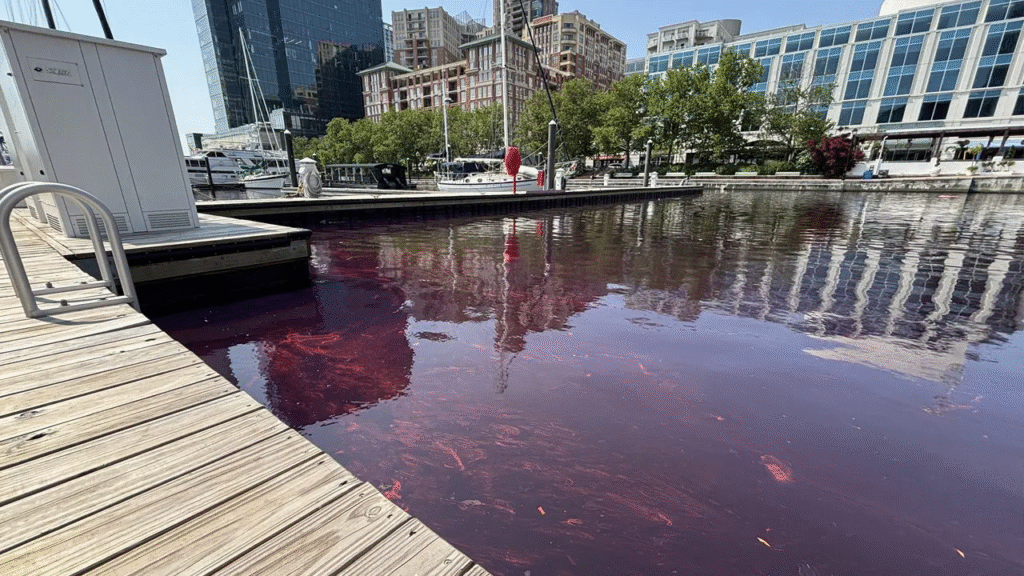Emergency response teams raced against time along Baltimore’s waterfront after a significant diesel fuel spill turned part of the city’s harbor a conspicuous red, alarming residents and threatening one of the most visited areas in Maryland. The spill, which officials now estimate to be around 2,000 gallons, occurred Wednesday morning and led to a widespread environmental response that continued into the early hours of Thursday.
These tanks are connected to backup generators essential to hospital operations during power outages.
A spokesperson for Johns Hopkins University explained in a statement to CNN that the incident occurred during a standard fuel delivery by a third-party contractor. “On Wednesday morning, during a routine refueling operation conducted by an external vendor, two diesel tanks supplying backup power systems for our East Baltimore campus were inadvertently overfilled. This led to an overflow of diesel fuel,” the spokesperson said.
Johns Hopkins first reported the leak around 11:00 a.m., estimating it at just 100 gallons. However, as further assessments were carried out by local and federal agencies, the volume of the spill was revised upward to 2,000 gallons—a significant environmental hazard for the busy harbor area.
The spill occurred near the East Harbor Marina on the Patapsco River, not far from Fells Point, a historic and bustling waterfront neighborhood filled with restaurants, shops, and tourist attractions. A visible slick, tinted red due to a dye added to diesel fuel for identification purposes, spread across the surface of the water. The stained area measured approximately 100 by 250 yards, with the most noticeable discoloration near the South Central Avenue Bridge.
In a joint statement, Maryland Governor Wes Moore and Baltimore Mayor Brandon M. Scott sought to calm public concerns while also affirming the seriousness of the situation. “The red coloration seen in the harbor is the result of dye in the diesel fuel, not a sign of hazardous contamination,” the statement read. “At this time, there is no threat to the drinking water supply in the region.”
Governor Moore also took to social media to reassure residents and share that he had visited the affected site to monitor the situation firsthand. “I’m here at the spill site near Fells Point, ensuring coordination across agencies and pledging full support for a thorough cleanup,” Moore posted. His visit underscored the urgency and high-level attention the incident attracted due to its location and potential ecological consequences.
The U.S. Coast Guard has taken the lead in the cleanup effort. Working in partnership with nearly a dozen agencies—including the Maryland Department of the Environment, Baltimore City Department of Public Works, and emergency management teams—the Coast Guard deployed specialized pollution response units to tackle the diesel floating on the water’s surface.
Additionally, containment booms have been placed around the spill to prevent it from spreading further into the harbor and surrounding waterways. “Containment and cleanup operations are ongoing and will continue through the night,” a Coast Guard official stated. “Our teams are actively working to recover all material that can be safely extracted from the water.”
Although there have been no confirmed reports of harm to marine life or long-term damage yet, environmental officials remain cautious. Diesel spills pose significant threats to aquatic ecosystems, especially in confined urban waterways like the Patapsco River. Even relatively small spills can reduce oxygen levels in the water, affect fish and bird populations, and leave a long-lasting residue on shorelines and piers.

The Maryland Department of the Environment is conducting a parallel investigation into the spill to determine the full scope of the impact and whether any environmental regulations were violated. A spokesperson said that fines and additional regulations could be considered depending on the findings.
Johns Hopkins has pledged full cooperation with all regulatory agencies and stated that internal reviews are underway to understand how the overfill happened and whether any procedural failures contributed. “We are deeply concerned about the impact of this spill and are working with authorities at every level to support the response and prevent future incidents,” the Johns Hopkins spokesperson said.
The incident has also raised questions about the vulnerability of critical infrastructure—like hospital fuel systems—in densely populated urban areas. While backup power is essential for medical facilities, especially those as large as Johns Hopkins, proper containment and delivery safeguards are equally crucial to prevent environmental disasters.
“It’s scary to see the water turn red and know that fuel is in the harbor,” said Andrew Lopez, a boat owner docked near the marina. “But it looks like they got on it pretty fast. Still, I hope there aren’t long-term effects.”
Others worried about the potential impact on tourism. “This is one of the busiest parts of Baltimore in the summer. If word gets out that the harbor is polluted, people might stay away,” said Jasmine Walker, who runs a kayak rental business near the affected area.
As cleanup continues, the focus remains on minimizing environmental impact and ensuring no residual contamination spreads further. Officials have not yet provided a timeline for full recovery, though they have committed to regular updates as more information becomes available.
CNN has reached out to both Johns Hopkins University and the U.S. Coast Guard for more detailed information on the ongoing cleanup and any forthcoming regulatory actions. Meanwhile, Maryland’s environmental protection agencies remain on high alert, watching for any signs of worsening conditions in the harbor.
In the coming days, local residents, environmental groups, and city leaders will be monitoring the situation closely, hoping that the swift response and coordinated efforts will prevent long-term damage to one of Baltimore’s most treasured landmarks.
